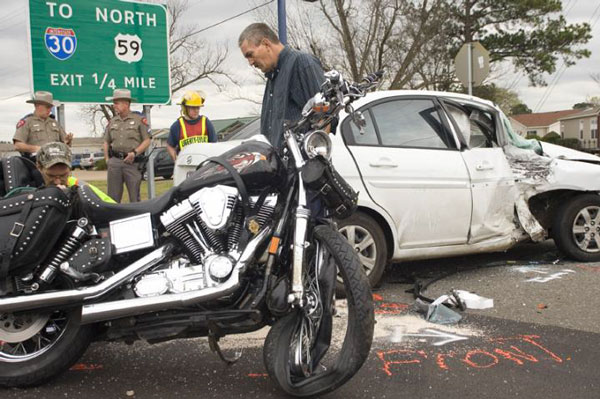After the Fall: Your Motorcycle Accident Checklist
 Accidents happen, so be prepared for when they do!
Accidents happen, so be prepared for when they do!
1. Listen/ Observe. Listen to what the defendant says at the accident scene. Listen for If the defendant makes admissions at the accident scene by saying “sorry”, “I wasn’t watching”, “I didn’t see you”, etc. Observe what the defendant does and says. Often times, the non-verbal actions of defendants will tell you what they think. If they are pointing at their car and you, it is their body language that is explaining that they are either blaming you or themselves for the accident.
2. Do not say anything that would make you appear at fault. Do not say “it was my fault, ” or “I didn’t have any control over my bike.” Police, state highway patrol troopers or deputy sheriffs and emergency room staff will always ask questions about how the accident happened. Focus on what the defendant did or did not do. Give detailed explanations of what you saw happening in front of you, more so than about your actions. If you are to explain your actions, keep them honest, simple, and short. And always clearly explain what a normal rider would have been doing in your situation. If it appears that the officer does not believe you, or has obvious preconceived ideas about bikers, make sure you make your case to him by citing obvious facts that would support your side of the story. For example, if the driver was pulling across your path of travel, cite the fact that the cars behind him were already stopped, waiting for you to pass. Outside facts will help protect your case.
3. Go to the emergency room. The need to get checked out is essential. We cannot stress that this myth: “Your injuries are going to just resolve themselves” is just a myth. The chances of your injuries resolving themselves are slim to none. The emergency room can give you a fair overall review of what your body went through following the impact and what you should do to minimize your pain and injury. It provides a base line of information regarding your injuries close in proximity to the time of the accident. Lawyers hate it when they have an injured client and the defense attorney argues: “If he was so injured, why didn’t he go to the emergency room?” or “Why didn’t he or she talk to anybody about his or her injury?”
4. Follow up with your physician. If the hospital says you should follow up in two days, follow up in two days. If you do not have health insurance, go back to the hospital. Most doctors offices and hospitals will work with you concerning a payment plan. If your injuries are very severe, the doctors will have to treat you. But always remember: Doctors’ offices have the right to refuse treatment, so do not get upset if they do not provide treatment.
5. Do not talk about the accident with anyone, including your doctor. Always assume this: Any statements you make about the accident will be written down and may be taken out of context. Doctors and nurses, specifically, may write down your words in a completely different context than how you meant to use them. Those statements always come up later in court.
6. Treat until you feel you can tolerate the pain. The old philosophy that says the more you treat the more money you get is completely false. Insurance companies and juries want a champion or an underdog for a plaintiff. Work hard at getting yourself better. Juries are more likely to award money to people who try to return to their old selves, yet work and deal with the pain. However, if you are not getting better, seek out specialists and make sure to follow up with your physician and heed his/her orders for treatment.
7. Take photos. If your injuries are visible (black and blue marks or open wounds, for example) take photos of them. Take photos of your damaged bike and any surgical scars on your body. Take weekly photographs. A photograph really is worth a thousand words. Images will tell a better story than any words we can put down on paper. Photographs become the foundation of your case should the matter go to trial.
8. Keep a journal. Keep a journal of your weekly problems and pain caused by the accident and the resulting injuries. When you go to the jury to explain your case, you need to tell stories of how the injuries affected you. Just saying I was in pain is not enough these days, and memories of significant problems can fade over time. You need to tell how the injuries affected you in a typical situation where you were not able to do what you would normally do, or were unable to enjoy the activity as you usually would have. Stories like these are an important part of any accident injury case.
Article courtesy of HarleyDavidsonFever, your source for all things Harley.
Anything else we should add to this list? Let us know in the Forums!
Ape Hangers: How High is Too High and Other Monkey Business
Happy Harley-Days: Five Awesome Harley-Davidson Holiday Gift Ideas
Buying Harley Davidson Parts on eBay: A User’s Guide
Calgary’s Noise Snare: A Speed Camera for Loud Pipes
